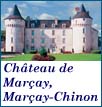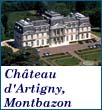Castle Hotels of Centre and Pays de la Loire

![]() Château de Pray
Château de Pray
![]() Château de Marçay
Château de Marçay
![]() Château d’Artigny
Château d’Artigny
![]() Château d’Esclimont
Château d’Esclimont
![]() Château de Chissay
Château de Chissay
![]() Château de la Barre
Château de la Barre
![]() Château des Briottières
Château des Briottières
Haven’t decided on a hotel yet? You can look at other available hotels in the regions of Centre and Pays de la Loire with Booking.com.
For the sheer grandeur of its sights, the Loire Valley reigns supreme over any other region in France. Come to the Loire to see the magnificent, stately châteaux that sit like jewels along its famous river. But another enticement is driving through lovely countryside full of woods and lush foliage, traveling from one old village to the next, each more enchanting than the last.
The region has been thick with castles since the Viking invasions in the 9th century. The 11th century saw massive battlements, moats, and arrow-slit windows added, and the introduction of the cannon to warfare in the 15th century changed the nature of the defensive fortress forever. The Renaissance brought extravagant creature comforts to resplendent pleasure palaces, now among the architectural wonders of the world.
Some great reasons to visit
![]() The châteaux The glory of the Middle Ages and Renaissance are embodied in the architectural wonders of these magnificent castles. From the 15th to the 18th century, French royalty and the less-than-royal personages spent enormous fortunes to create a playground of glorious grand country estates. Like a fine museum, don’t try to see everything (crowds can slow you down) but focus on a few. For starters:
The châteaux The glory of the Middle Ages and Renaissance are embodied in the architectural wonders of these magnificent castles. From the 15th to the 18th century, French royalty and the less-than-royal personages spent enormous fortunes to create a playground of glorious grand country estates. Like a fine museum, don’t try to see everything (crowds can slow you down) but focus on a few. For starters:
Château de Chambord—Straight out of a book of fairy tales, Chambord is the largest of all the Loire châteaux and the pinnacle of the architecture of the French Renaissance.
Château de Blois—Known as the “Versailles of the Renaissance” when François I took up residence here, it combines the architecture of three kings, each of whom left their personal style. The two most visited highlights are Catherine de Medici’s study and the site of the murder of the Duke of Guise (by order of Henry III, Catherine de Medici’s son).
Château de Chenonceau My personal favorite, Chenonceau romantically spans the Cher River. It’s everything a Renaissance pleasure palace should be: the architecture, interior decoration and gardens are nothing less than sublime. Over a period of 400 years, a series of women—queens, wives, and a famous mistress—have transformed the property into one of the world’s most beautiful structures.
Château de Villandry The last of the great Renaissance châteaux to be built and now privately owned, Villandry was never the home of French royalty. The most remarkable offering of the château is its magnificent gardens, considered to be the most beautiful formal gardens in all of France.
Château de Chaumont High on a bluff overlooking the Loire, you must walk up a winding and steep road from the village and cross a drawbridge to enter the castle. Chaumont doesn’t attract the busloads of visitors as the other châteaux, which makes a visit especially appealing. Following the death of Henri II, Catherine de Medici booted out his mistress, Diane de Poitiers, from Chenonceau, and gave her Chaumont instead.
Château d’Azay-le-Rideau Built on an island, the blue slate roof, turrets and towers of this fairy-tale château reflect in the surrounding moat. The atmosphere here is romantic and picturesque. After dark, the château comes to life in a son et lumière show.
![]() Hot-air ballooning over the Loire Valley For a once-in-a-lifetime thrill, soar silently in a hot-air balloon over the châteaux of the Loire Valley and celebrate with a champagne toast for the grand finale.
Hot-air ballooning over the Loire Valley For a once-in-a-lifetime thrill, soar silently in a hot-air balloon over the châteaux of the Loire Valley and celebrate with a champagne toast for the grand finale.
![]() Chinon You’ll think you’re on a movie set depicting the Middle Ages while strolling on the cobblestone streets past half-timber houses in the historic part of Chinon. A massive ruined fortress that was once the favored castle of the Plantagenet kings dominates the town.
Chinon You’ll think you’re on a movie set depicting the Middle Ages while strolling on the cobblestone streets past half-timber houses in the historic part of Chinon. A massive ruined fortress that was once the favored castle of the Plantagenet kings dominates the town.
![]() Chartres Glorious and divine no matter the faith of the visitor, the Cathédral Notre-Dame de Chartres attains perfection in its medieval architecture, sculpture, and exquisite stained glass. Built primarily in the 12th and 13th century, it has been a site of worship since before Gallo-Roman times.
Chartres Glorious and divine no matter the faith of the visitor, the Cathédral Notre-Dame de Chartres attains perfection in its medieval architecture, sculpture, and exquisite stained glass. Built primarily in the 12th and 13th century, it has been a site of worship since before Gallo-Roman times.
![]() Bourges At the eastern end of the Loire Valley, historic Bourges looks right out of the Middle Ages, with its timbered houses and soaring cathedral. In 52 B.C., Julius Caesar called Bourges the finest city in Gaul. Two worthy sights are the 13th-century Cathédrale St-Étienne, one of the most stunning Gothic cathedrals in France, and the Palais Jacques-Coeur, home of the greatest merchant of the Middle Ages, financier, and foreign minister to Charles VII.
Bourges At the eastern end of the Loire Valley, historic Bourges looks right out of the Middle Ages, with its timbered houses and soaring cathedral. In 52 B.C., Julius Caesar called Bourges the finest city in Gaul. Two worthy sights are the 13th-century Cathédrale St-Étienne, one of the most stunning Gothic cathedrals in France, and the Palais Jacques-Coeur, home of the greatest merchant of the Middle Ages, financier, and foreign minister to Charles VII.
![]() Fontevraud-l’Abbaye The 12th-century Abbaye Royale de Fontevraud is the largest medieval abbey in Europe. Before the French Revolution, the remains of Henry II of England, Eleanor of Aquitaine, and Richard the Lion-Hearted were entombed here.
Fontevraud-l’Abbaye The 12th-century Abbaye Royale de Fontevraud is the largest medieval abbey in Europe. Before the French Revolution, the remains of Henry II of England, Eleanor of Aquitaine, and Richard the Lion-Hearted were entombed here.
![]() Angers At the western end of the Loire Valley, come to Angers to visit the moated, 17-towered, black-and-white striped Château d’Angers, home of the counts of d’Anjou and the Plantagenets and especially the Apocalypse Tapestries (Tenture de l’Apocalypse). 77 panels stretching 100 m (328 ft) depict amusing and horrifying scenes from the Book of Revelation.
Angers At the western end of the Loire Valley, come to Angers to visit the moated, 17-towered, black-and-white striped Château d’Angers, home of the counts of d’Anjou and the Plantagenets and especially the Apocalypse Tapestries (Tenture de l’Apocalypse). 77 panels stretching 100 m (328 ft) depict amusing and horrifying scenes from the Book of Revelation.






